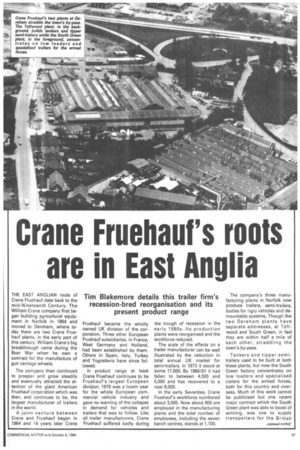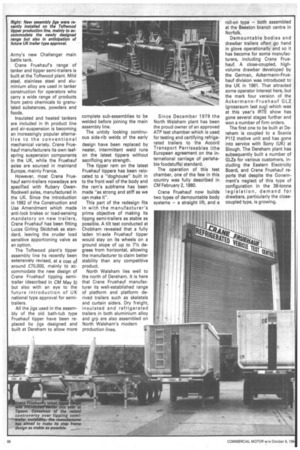Crane Fruehauf's roots are in East Anglia
Page 91

Page 92

If you've noticed an error in this article please click here to report it so we can fix it.
THE EAST ANGLIAN roots of Crane Fruehauf date back to the mid-Nineteenth Century. The William Crane company first began building agricultural equipment in Norfolk in 1864 and moved to Dereham, where today there are two Crane Fruehauf plants, in the early part of this century. William Crane's big breakthrough came during the Boer War when he own a contract for the manufacture of gun carriage wheels.
The company then continued to prosper and grow steadily and eventually attracted the attention of the giant American Fruehauf corporation which was then, and continues to be, the largest manufacturer of trailers in the world.
A joint venture between Crane and Fruehauf began in 1964 and 14 years later Crane Fruehauf became the wholly owned UK division of the corporation. Three other European Fruehauf subsidiaries, in France, West Germany and Holland, had been extablished by them. Others in Spain, Italy, Turkey and Yugoslavia have since followed.
In product range at least Crane Fruehauf continues to be Fruehauf's largest European division. 1979 was a boom year for the whole European commercial vehicle industry and gave no warning of the collapse in demand for vehicles and trailers that was to follow. Like all trailer manufacturers, Crane Fruehauf suffered badly during the trough of recession in the early 1980s. Its production plants were reorganised and the workforce reduced.
The scale of the effects on a trailer manufacturer can be well illustrated by the reduction in total annual UK market for semi-trailers. In 1973 it stood at some 17,500. By 1980/81 it had fallen to between 4,500 and 5,000 and has recovered to a near 8,000.
In the early Seventies, Crane Fruehauf's workforce numbered about 3,000. Now about 800 are employed in the manufacturing plants and the total number of employees, including the seven bench centres, stands at 1,100.
The company's three manufacturing plants in Norfolk now produce trailers, semi-trailers, bodies for rigid vehicles and demountable systems. Though the two Dereham plants have separate addresses, at Toftwood and South Green, in fact they are within half a mile of each other, straddling the town's by-pass.
Tankers and tipper semitrailers used to be built at both these plants, but now the South Green factory concentrates on low loaders and specialised trailers for the armed forces, both for this country and overseas. Much of this work cannot be publicised but one recent major contract which the South Green plant was able to boast of winning, was one to supply transporters for the British Army's new Challenger main battle tank.
Crane Fruehauf's range of tanker and tipper semi-trailers is built at the Toftwood plant. Mild steel, stainless steel and aluminium alloy are used in tanker construction for operators who carry a wide range of products from petro chemicals to granulated substances, powders and foods.
Insulated and heated tankers are included in th product line and air-suspension is becoming an increasingly popular alternati v e to the conventional mechanical variety. Crane Fruehauf manufacturers its own leaf spring suspension components in the UK, while the Fruehauf axles are sourced in mainland Europe, mainly France.
However, most Crane Fruehauf semi-trailers nowadays are specified with Rubery OwenRockwell axles, manufactured in the UK. Since the introduction in 1982 of the Construction and Use Amendment which made anti-lock brakes or load-sensing mandatory on new trailers, Crane Fruehauf has been fitting Lucas Girling Skidchek as standard, leaving the cruder load sensitive apportioning valve as an option.
The Toftwood plant's tipper assembly line hs recently been extensively revised, at a COSI of around £70,000, mainly to accommodate the new design of Crane Fruehauf tipping semi
trailer (described in CM May 5) but also with an eye to the
future introduction of UK national type approval for semitrailers.
All the jigs used in the assembly of the old bath-tub type Fruehauf tipper have been replaced by jigs designed and built at Dereham to allow more complete sub-assemblies to be welded before joining the main assembly line.
The untidy looking continuous side-rib welds of the early design have been replaced by neater, intermittent weld runs on the latest tippers without sacrificing any strength.
The tipper ram on the latest Fruehauf tippers has been relocated to a "doghouse" built in to the front wall of the body and the ram's subframe has been made "as strong and stiff as we can make it".
This part of the redesign fits in with the manufacturer's prime objective of making its tippng semi-trailers as stable as possible. A tilt test conducted at Chobham revealed that a fully laden tri-axle Fruehauf tipper would stay on its wheels on a ground slope of up to 71/2 degrees from horizontal, allowing the manufacturer to claim better stability than any competitive product.
North Walsham lies well to the north of Dereham. It is here that Crane Fruehauf manufacturer its well-established range of platform and platform derived trailers such as skeletals and curtain siders. Dry freight, insulated and refrigerated trailers in both aluminium alloy and grp are also assembled on North Walsham's modern production lines. Since December 19Th the North Walsham plant has been the proud owner of an approved ATP test chamber which is used for testing and certifying refrigerated trailers to the Accord Transport Perrissables (the European agreement on the international carriage of perishable foodstuffs) standard.
The operation of this test chamber, one of the few in this country was fully described in CM February 2, 1980.
Crane Fruehauf now builds two types of demountable body systems — a straight ift, and a roll-on type — both assembled at the Beeston branch centre in Norfolk.
Demountable bodies and drawbar trailers often go hand in glove operationally and so it has become for some manufacturers, including Crane Fruehauf. A close-coupled, highvolume drawbar developed by the German, Ackermann-Fruehauf division was introduced to the UK in 1981. That attracted some operator interest here, but the mark four version of the Ackermann-Fruehauf GLZ (grossraum last zug) which was at this year's IRTE show has gone several stages further and won a number of firm orders.
The first one to be built at Dereham is coupled to a Scania P112 motive unit and has gone into service with Sony (UK) at Slough. The Dereham plant has subsequently built a number of GLZs for various customers, including the Eastern Electricity Board, and Crane Fruehauf reports that despite the Government's neglect of this type of configuration in the 38-tonne legislation, demand for drawbars, particularly the closecoupled type, is growing.




























































































































































